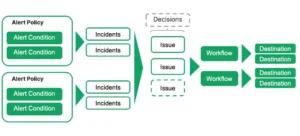Find out how to maximize The New Relic Synthetics Monitor. Learn how to set alerts, scripting, and various types of monitoring. Discover accurate strategies and the most advanced methods to boost performance monitoring within your application.
Relic Synthetics Monitoring offers an expansive set of tools designed to monitor websites and applications and detect issues before they affect customers, so assuring smooth software operation is more than an admirable goal; it is necessary. Suppose you’re an experienced DevOps engineer, IT professional, or software developer. In that case, understanding the accurate way to set up Synthetics Monitoring to work effectively in New Relic can significantly raise the efficiency of your applications.
Introduction to New Relic Synthetics Monitoring
The core of New Relic Synthetics Monitoring is more than uptime. It’s about providing an excellent user experience. In a way, it simulates user interactions and flow. Synthetics is a proactive solution for performance monitoring and can identify issues before they are visible to your clients.
Importance of Optimizing Synthetics Monitoring
Optimization isn’t just a buzzword. It’s crucial to harness technology to acquire extensive performance data. Adjusting the settings of your Synthetics Monitor application can give you deep insight into your application’s behavior and increase customer satisfaction and loyalty.
Understanding Synthetics Monitoring Alerts
Alerts within New Relic Synthetics are your primary defense against any potential problems. Alerts alert you of any issues impacting your system’s performance and allow you to act quickly to minimize adverse effects.

How to Set Up and Customize Alerts
Configuring and modifying alerts in New Relic Synthetics requires understanding your specific application’s requirements. First, you must determine what you want to track to tailor the alerts you send to meet these requirements.
Setting Up Alert Policies in New Relic
Effective alert policies are vital to ensuring timely and accurate relevant alerts. This article will guide you in creating alert policies that will track the health of your application without overloading your email inbox with false negatives.
Best Practices for Alerts
- Create clear thresholds and criteria to trigger alerts.
- Utilize New RRelic’s incident preference settings to reduce alert sound.
- Check and revise your guidelines regularly based on previous alerts.
Using Synthetics Monitoring Scripts
The scripts can monitor complex scenarios, from simple checking pings to complicated user interactions. Within New Relic Synthetics, scripts enable your tests and monitor the application in a way akin to actual user behavior.
Best Practices for Writing Scripts
Effective monitoring scripts require an equilibrium between completeness and effectiveness:
- Make sure your scripts are clean and adequately detailed.
- Update your scripts regularly to reflect the latest changes to the application.
- Conduct extensive tests of scripts before deploying them into environments for production.
Monitoring Types in New Relic Synthetics
New Relic offers various monitoring types, including API checks, browser tests, and customized browser tests that can meet your specific application monitoring requirements. Knowing when and how to use these tests will help you complete an overall view of your application’s performance.
Customizing Monitoring Types for Specific Use Cases
Every app is distinct and needs a customized monitoring strategy. We’ll guide you through customizing New Relic Synthetics Monitoring for different types of applications, regardless of whether you’re managing mobile or web applications or complex microservices structures.
Combining Synthetics Monitoring With Other Relic Features that are brand new
The New RRelic’secosystem provides an impressive integration capability, which allows Synthetics Monitoring data to improve the insights of APM, Insights, and various other tools. This article explains how integrating various New Relic tools can deliver an extensive monitoring system.
Analyzing Synthetics Monitoring Data
Data is the underlying factor of optimizing performance. This article will show how to interpret Synthetics Monitoring data energetically, helping you make informed choices about improvements to performance and improvements.
Advanced Synthetics Monitoring Techniques
If you’re ready to step up your monitoring, advanced technologies can provide better insights and more detailed monitoring of the applications’ performance monitoring methods.
Troubleshooting Synthetics Monitoring Issues
Even when you have a robust monitoring system installed, issues can develop. This article will cover the most common problems using Synthetic Monitoring. We’ll also provide strategies for rapid solution and troubleshooting, ensuring your application runs at its best.
Monitoring Synthetic Transactions for Performance Testing
Testing performance is essential for today’s technological environment. Synthetics Monitoring to monitor synthetic transactions offers a secure method to measure and increase the performance of your application based on the user’s behavior.
Synthetics Monitoring Best Practices
In conclusion, we’ll outline our accurate methods for effectively using the New Relic Synthetics Monitor. Utilizing these methods can improve the effectiveness of your monitoring, ensure the availability of your software, and provide users with the perfect customer experience.
FAQ’s
-
What is New Relic Synthetics Monitoring?
-
-
- Relic Synthetics Monitor is an application developed to proactively monitor APIs, apps, and websites in different regions worldwide to guarantee their correct functioning and user experience.
-
-
What kinds of scripts should be used for Synthetics monitoring in New Relic?
-
-
- You can use various types of scripts within New Relic Synthetics, including API tests, browser tests, and scripted tests. These allow you to mimic user interactions using API calls and evaluate your application’s performance.
-
-
How do I improve Synthetics Monitoring to suit my particular application?
-
-
- Optimizing Synthetics Monitoring requires customized monitoring settings and alert policies, writing effective scripts, analyzing information from monitoring to find performance issues, and boosting the user experience.
-
-
Do I have the ability to integrate Synthetics Monitoring into the other New Relic features?
-
-
- Yes; you can use Synthetics Monitoring alongside the other New Relic features such as APM (Application Performance Monitoring), Insights (Analytics Platform), and Dashboards to receive complete visibility into your application’s performance and health.
-
-
What are the perfect methods for creating synthesized Monitoring scripts?
-
-
- An exemplary method for creating Synthetics Monitoring scripts is to make sure that the script is reliable, together with variables for dynamic information, handling authentication and sessions, including errors handling and making changes to the script to take account of modifications to applications.
-
-
What can Synthetics Monitoring benefit in performance tests?
-
-
- Synthetics Monitoring can be utilized to test performance by replicating synthetic transactions, evaluating the response time, analyzing the performance indicators, and finding problems before they affect real-world users.
-
-
What are the common problems to be faced by Synthetics Monitoring? And how can they be solved?
-
- Common issues with synthetic monitoring include false alerts, script maintenance across various environments, and interpretation of information from the monitoring. Proper alert tuning, script versions, customizing for specific environments, and data-driven analysis address these challenges.
Conclusion
Optimizing the New Relic Synthetics Monitoring can be an ongoing adaptation, learning, and improvement procedure. Following the principles and methods discussed in this post, you can ensure that your apps perform to the highest standards and surpass expectations. Keep in mind that the purpose of Synthetics Monitoring isn’t just to inform you about difficulties but to help you avoid and predict problems while ensuring an excellent customer experience.
After you’ve gathered the expertise to maximize the New Relic Synthetics Monitoring system, Take the next step. Apply these methods, look into additional resources in New Relic, and refine your monitoring procedures. Your users and your applications will thank you for your efforts.

